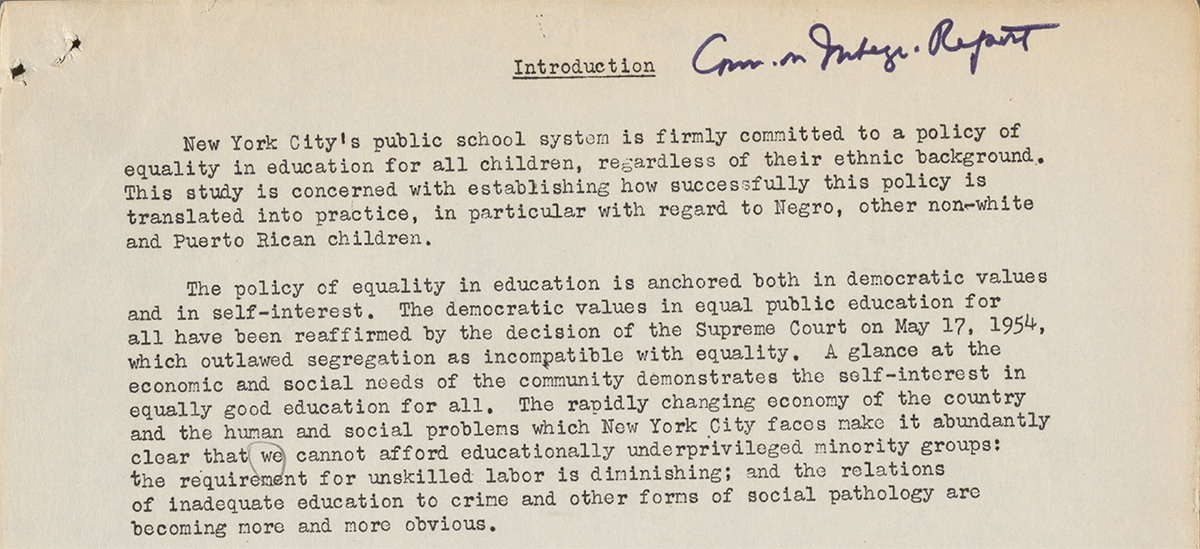You are here:
Commission on Integration, Subcommittee on Zoning Draft Report, excerpt

Date: Mar 2, 1956
Caption: The New York City Board of Education appointed the 1956 Commission on Integration to study racial segregation in New York City schools and make recommendations for integrating them. This is an excerpt from one of their drafts.
In its 1954 decision in Brown v. Board of Education, the US Supreme Court ruled that school segregation was unconstitutional because separate schools for Black children were “inherently unequal.” Citing the work of Black psychologist and City College professor Kenneth Clark, among others, the court argued that segregated schools were unconstitutional because segregation taught a message of racial superiority for white students and racial inferiority for Black students.1
Ella Baker commented that “New York didn’t act right after the ‘54 [Brown] decision. It didn’t have any reason to act, so you had to help it to realize it.” She also noticed the tendency among national civil rights organizers to focus on the South: “They were always talking about the poor people down South. And so the question was, what do you do about the poor children right here?”2 Baker became a key organizer against segregation in New York City schools.
As the first woman president of the New York City chapter of the National Association for the Advancement of Colored People (NAACP), Ella Baker used multiple approaches to advocate for school desegregation. She worked within the system, as a member of the Board of Education’s Commission on Integration, which produced this report. She also helped organize advocacy groups including Parents in Action Against Educational Discrimination, convened protests and rallies to put pressure on elected officials, and worked with young people as well.3
As a member of the Commission on Integration’s zoning subcommittee, Baker advocated for the Board to use its powers to shape school zones to foster integration. Zones indicated which schools students living in a certain area attended. Much to Baker’s dismay, the Commission on Integration produced a final report that included much less information about the shape and extent of segregation and inequality in New York schools than the draft above. The revealing statistics about unequal schooling contained in this draft did not make it into the final version. The final report made only modest suggestions for changes and included no commitments that segregation would end.4
-
Brown v. Board of Education of Topeka, 347 U.S. 483 (1954), https://catalog.archives.gov/id/1656510. ↩︎
-
Quoted in Barbara Ransby, Ella Baker & the Black Freedom Movement: A Radical Democratic Vision (Chapel Hill: University of North Carolina Press, 2003), 153. ↩︎
-
Ransby, Ella Baker & the Black Freedom Movement, 149-152; Charles Payne, “Give Light and the People Will Find a Way’: Ella Baker and Teaching as Politics,” in Teach Freedom: Education for Liberation in the African-American Tradition, ed. Charles Payne and Carol Sills Strickland (New York: Teachers College Press, 2008), 56-64. ↩︎
-
Board of Education of the City of New York, “Toward the Integration of Our Schools: Final Report of the Commission on Integration,” 1958, in Ella Baker Papers, Box 4, Folder 20, Schomburg Center for Research in Black Culture of the New York Public Library, https://archives.nypl.org/scm/20899. ↩︎
Categories: K-12 organizing, community activism
This item is part of "Before the Boycotts: White Liberal Resistance" in "Boycotting New York’s Segregated Schools"
Item Details
Date: Mar 2, 1956
Creator: Board of Education of New York City, Commission on Integration, Subcommittee on Zoning
Source: Annie Stein Papers, Columbia University Rare Books and Manuscript Library
Copyright: Under copyright. Used with permission. Courtesy of the Columbia University Rare Books and Manuscripts Library.
How to cite: “Commission on Integration, Subcommittee on Zoning Draft Report, excerpt,” Board of Education of New York City, Commission on Integration, Subcommittee on Zoning, in New York City Civil Rights History Project, Accessed: [Month Day, Year], https://nyccivilrightshistory.org/gallery/subcommittee-on-zoning.
Questions to Consider
- According to the subcommittee’s draft, why were New York City schools segregated? Why was the segregation of New York City schools a problem? What do you think of these explanations?
- What narratives within the draft report help to hide the actions that created and sustained segregation within and between New York public schools?
- In 2014, researchers identified New York City schools as some of the most segregated in the U.S. Soon after, Mayor Bill de Blasio created a “School Diversity Advisory Group” for the New York City Department of Education to discuss ways to address this issue. How do you think Ella Baker would feel knowing about the continued segregation of New York schools? What advice do you think she would offer the School Diversity Advisory Group?
References
How to Print this Page
- Press Ctrl + P or Cmd + P to open the print dialogue window.
- Under settings, choose "display headers and footers" if you want to print page numbers and the web address.
- Embedded PDF files will not print as part of the page. For best printing results, download the PDF and print from Adobe Reader or Preview.
